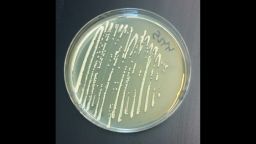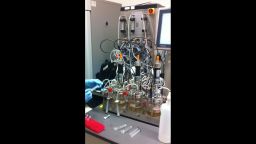Story highlights
Scientists have bioengineered yeast to make opioid compounds
It takes thousands of liters of yeast to make one dose of medication
Could people home-brew heroin? Well, not quite, but that notion became more plausible this month as scientists at Stanford University announced developing a technique essentially to covert yeast into potent painkillers.
Heroin, and narcotics such as Vicodin and OxyContin, all belong to the opioid family and can only be derived from the tarry sap of the poppy plant.
But by manipulating yeast, Stanford’s Christina Smolke and her team are able to bypass the flower all together.
Bioengineered painkillers
“What we’ve done here is we’ve put in synthetic DNA, which encodes new directions in the yeast cells,” Smolke said.
Genes from rats, bacteria and other poppy plants have been inserted into the yeast to produce thebaine, a compound that can then be converted into morphine or codeine. Researchers have also been able to create another strain to make hydrocodone, the active ingredient in Vicodin.

The motivation behind this all is eventually to create safer medications – pills that can dull the pain and be less addictiive but not have the negative side effects that opioids have such as slowing down breathing. In addition, manufacturing of these medicines wouldn’t have to rely on current poppy supplies, which can be subject to political whims and weather.
So can just anyone go to the grocery store and buy some yeast to tinker with in their kitchen? Not anytime soon.
First of all, Smolke explained that the yeast has to be grown in a controlled environment. “At home, you stick yeast at the bottom of a barrel, but in labs, everything is controlled in special vessels,” she said.
Home-brewing narcotics

And just to make sure, Smolke and her team tried to grow yeast, in essence, at home. “We grew them under home-brew condition, and you get no production of these compounds. It’s just to say, that there’s this divide in how easy it can be transferred to a home-brew-type setting. And there will be some real challenges with how these strains grow,” she said.
Currently, even under the perfect lab conditions, it takes thousands of liters of yeast to yield one dose of medicine. The research isn’t at commercial levels yet, Smolke said. “We need to improve the yield, and the rate at how the yeast converts into these molecules.”
But it’s the future of where this technology is going that has people concerned. What happens when it becomes more efficient and gets in the wrong hands?
Looking to the future
“I’m not that worried about what’s taking place now,” said Kenneth Oye, a political science and engineering professor at the MIT. But he said there needs to be discussions on the potential danger this technology could bring. “It is really moving fast.”
Ed You, a supervisory special agent with the FBI, agrees. “The efficiencies aren’t there yet, but they will get there,” he said. “The ultimate goal is to make this a marketable product for health care. And you can’t look at the home-brew as a snapshot. We need to look at a holistic approach.”
In fact, You has already begun discussions with researchers such as Smolke and Oye as well as other scientists and policy experts on how to make this process safe for the future.
Smolke and her team do have a license through the Drug Enforcement Administration for her strains. And it is something about which the DEA is concerned. “The last thing we want to say is we wish we put more controls, but at this point where we are now, we feel they are in place,” said DEA spokesman Eduardo Chavez.
So, just how fast is the future coming? Sooner than you may think. “I think the technology can be developed straight up, enter into commercial scale up, within two years or so,” Smolke said.
So maybe Walter White’s protégé could be producing yeast-made heroin in a future television series.
